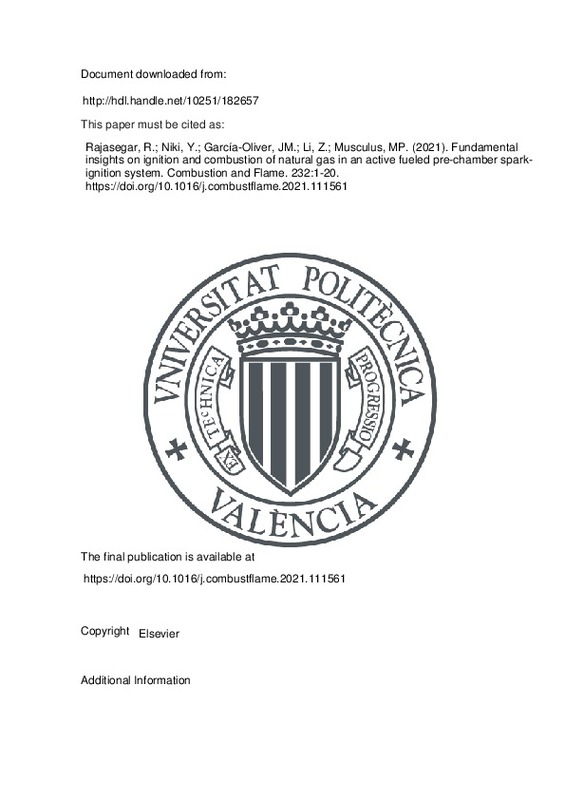JavaScript is disabled for your browser. Some features of this site may not work without it.
Buscar en RiuNet
Listar
Mi cuenta
Estadísticas
Ayuda RiuNet
Admin. UPV
Fundamental insights on ignition and combustion of natural gas in an active fueled pre-chamber spark-ignition system
Mostrar el registro sencillo del ítem
Ficheros en el ítem
| dc.contributor.author | Rajasegar, Rajavasanth
|
es_ES |
| dc.contributor.author | Niki, Yoichi
|
es_ES |
| dc.contributor.author | García-Oliver, José M
|
es_ES |
| dc.contributor.author | Li, Zheming
|
es_ES |
| dc.contributor.author | Musculus, Mark P.B.
|
es_ES |
| dc.date.accessioned | 2022-05-17T18:03:49Z | |
| dc.date.available | 2022-05-17T18:03:49Z | |
| dc.date.issued | 2021-10 | es_ES |
| dc.identifier.issn | 0010-2180 | es_ES |
| dc.identifier.uri | http://hdl.handle.net/10251/182657 | |
| dc.description.abstract | [EN] Pre-chamber spark-ignition (PCSI), either fueled or non-fueled, is a leading concept with the potential to enable diesel-like efficiency in medium-duty (MD) and heavy-duty (HD) natural gas (NG) engines. However, the inadequate scientific base and simulation tools to describe/predict the underlying processes governing PCSI systems is one of the key barriers to market penetration of PCSI for MD/HD NG engines. To this end, experiments were performed in a heavy-duty, optical, single-cylinder engine fitted with an active fueled PCSI module. The spatial and temporal progress of ignition and subsequent combustion of lean-burn natural gas using PCSI system were studied using optical diagnostic imaging and heat release analysis based on main-chamber and pre-chamber pressure measurements. Optical diagnostics involving simultaneous infrared (IR) and high-speed (30 kfps) broadband and filtered OH* chemiluminescence imaging are used to probe the combustion process. Following the early pressure rise in the pre-chamber, IR imaging reveals initial ejection of unburnt fuel-air mixture from the pre chamber into the main-chamber. Following this, the pre-chamber gas jets exhibit chemical activity in the vicinity of the pre-chamber region followed by a delayed spread in OH* chemiluminescence, as they continue to penetrate further into the main-chamber. The OH* signal progress radially until the pre-chamber jets merge, which sets up the limit to a first stage, jet-momentum driven, mixing-controlled (temperature field) premixed combustion. This is then followed by the subsequent deceleration of the pre-chamber jets, caused by the decrease in the driving pressure difference (AP) as well as charge entrainment, resulting in a flame front evolution, where mixing is not the only driver. Chemical-kinetic calculations probe the possibility of flame propagation or sequential auto-ignition in the second stage of combustion. Finally, key phenomenological features are then summarized so as to provide fundamental insights on the complex underlying fluid-mechanical and chemical-kinetic processes that govern the ignition and subsequent combustion of natural gas near lean-limits in high-efficiency lean-burn natural gas engines employing PCSI system. | es_ES |
| dc.description.sponsorship | This research was sponsored by the U.S. Department of Energy (DOE) Office of Energy Efficiency and Renewable Energy (EERE) . Optical engine experiments were conducted at the Combustion Re-search Facility of Sandia National Laboratories in Livermore, CA. Sandia National Laboratories is a multi-mission laboratory man-aged and operated by National Technology and Engineering So-lutions of Sandia, LLC., a wholly owned subsidiary of Honey-well International, Inc., for the U.S. Department of Energy's National Nuclear Security Administration (NNSA) under contract DE-NA0003525. We gratefully acknowledge the contributions of Keith Penney and Dave Cicone for their assistance in developing research tools and maintaining the optical engine. Jose M. Garcia-Oliver ac-knowledges the support of the Generalitat Valenciana government in Spain through Grant #Best/2019/176 during his scientific visit to the Combustion Research Facility. | es_ES |
| dc.language | Inglés | es_ES |
| dc.publisher | Elsevier | es_ES |
| dc.relation.ispartof | Combustion and Flame | es_ES |
| dc.rights | Reconocimiento - No comercial - Sin obra derivada (by-nc-nd) | es_ES |
| dc.subject | Pre-chamber spark-ignition | es_ES |
| dc.subject | Lean-premixed natural gas combustion | es_ES |
| dc.subject | Broadband chemiluminescence | es_ES |
| dc.subject | OH* chemiluminescence | es_ES |
| dc.subject | Infrared imaging | es_ES |
| dc.subject | Mixing-controlled | es_ES |
| dc.subject | Chemical kinetics | es_ES |
| dc.subject.classification | MAQUINAS Y MOTORES TERMICOS | es_ES |
| dc.title | Fundamental insights on ignition and combustion of natural gas in an active fueled pre-chamber spark-ignition system | es_ES |
| dc.type | Artículo | es_ES |
| dc.identifier.doi | 10.1016/j.combustflame.2021.111561 | es_ES |
| dc.relation.projectID | info:eu-repo/grantAgreement/GVA//BEST%2F2019%2F176/ | es_ES |
| dc.relation.projectID | info:eu-repo/grantAgreement/DOE//DE-NA-0003525/ | es_ES |
| dc.rights.accessRights | Abierto | es_ES |
| dc.contributor.affiliation | Universitat Politècnica de València. Departamento de Máquinas y Motores Térmicos - Departament de Màquines i Motors Tèrmics | es_ES |
| dc.description.bibliographicCitation | Rajasegar, R.; Niki, Y.; García-Oliver, JM.; Li, Z.; Musculus, MP. (2021). Fundamental insights on ignition and combustion of natural gas in an active fueled pre-chamber spark-ignition system. Combustion and Flame. 232:1-20. https://doi.org/10.1016/j.combustflame.2021.111561 | es_ES |
| dc.description.accrualMethod | S | es_ES |
| dc.relation.publisherversion | https://doi.org/10.1016/j.combustflame.2021.111561 | es_ES |
| dc.description.upvformatpinicio | 1 | es_ES |
| dc.description.upvformatpfin | 20 | es_ES |
| dc.type.version | info:eu-repo/semantics/publishedVersion | es_ES |
| dc.description.volume | 232 | es_ES |
| dc.relation.pasarela | S\447016 | es_ES |
| dc.contributor.funder | Generalitat Valenciana | es_ES |
| dc.contributor.funder | U.S. Department of Energy | es_ES |







![[Cerrado]](/themes/UPV/images/candado.png)

